Unlike the more popular destinations in South America, Paraguay remains a country largely untouched by tourism. With few well-known attractions and a limited number of foreign visitors—especially non-South Americans—this destination offers a unique experience: more authentic, catering to those who want to discover a less touristy side of the continent.
In this guide, we’ll help you plan your trip to Paraguay by presenting 50 essential tips to explore the country without hassle and gain a deeper understanding of its culture, cities, and everyday life.
We’ve organized this practical guide in a simple format, featuring 50 key things to know before visiting Paraguay. We include cultural aspects, travel advice, money-saving tips, and other helpful information for those wanting to see a country off the usual tourist paths.
Page Contents
Things to Know About Paraguay and Paraguayans
#1 Where is Paraguay?
With an area of 406,752 km² (about 157,000 sq mi), Paraguay is located in the heart of South America, bordered by Bolivia, Brazil, and Argentina. It used to be much larger but lost significant territory in wars with its neighbors.
Despite being relatively unknown to tourists, Paraguay boasts a varied landscape, featuring vast plains, riverine areas, and subtropical forests. It’s not a destination that impresses most travelers at first glance, but for those who visit, it offers a more authentic experience, as explained below.

#2 Paraguay’s Borders
Paraguay borders Brazil to the east and north, Argentina to the south, and Bolivia to the northwest. It is one of only two South American countries without direct access to the sea—the other being Bolivia.
Situated between two South American giants, Paraguay is deeply influenced by the cultures, economies, and even lifestyles of Brazil and Argentina. Its geographic position makes it a point of contact between these countries, which is also reflected in its own identity.
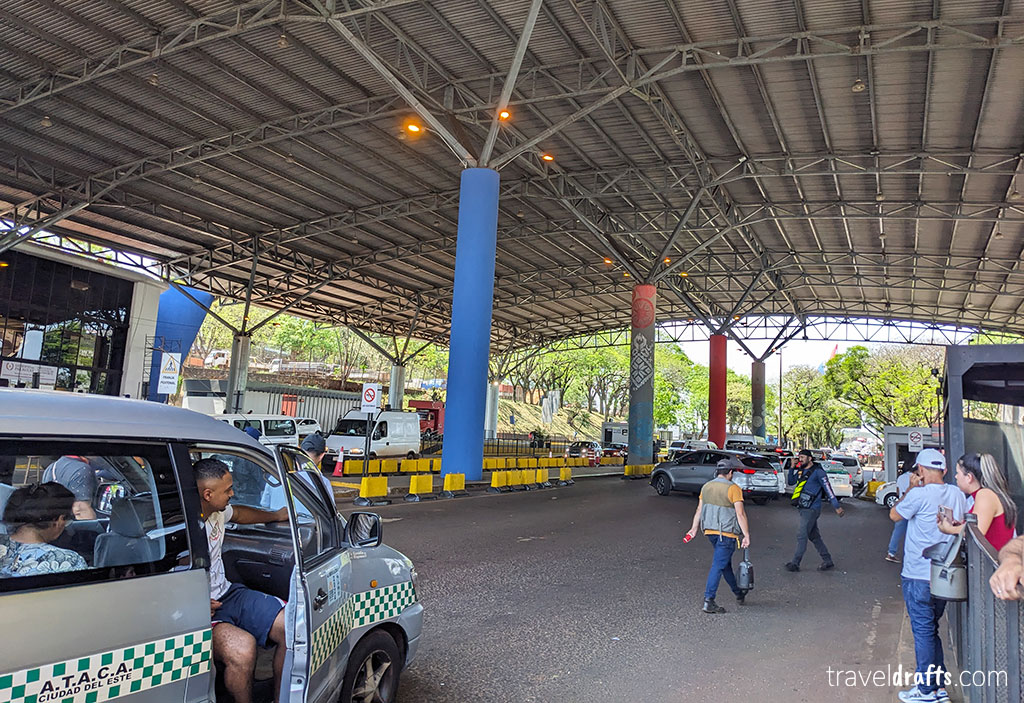
#3 Paraguay’s Major Rivers
Rivers are one of the country’s greatest natural assets. The Paraguay River, running from north to south, is the most important. Still, the Paraná River, which forms the border with Brazil and Argentina, also plays a crucial role in the country’s geography and daily life.
These rivers are much more than just waterways; they are vital arteries for the country. Historically, they were essential for transport and trade, connecting Paraguay to its neighbors and the rest of the world. Today, they remain crucial for transporting goods and are a fundamental source of life.
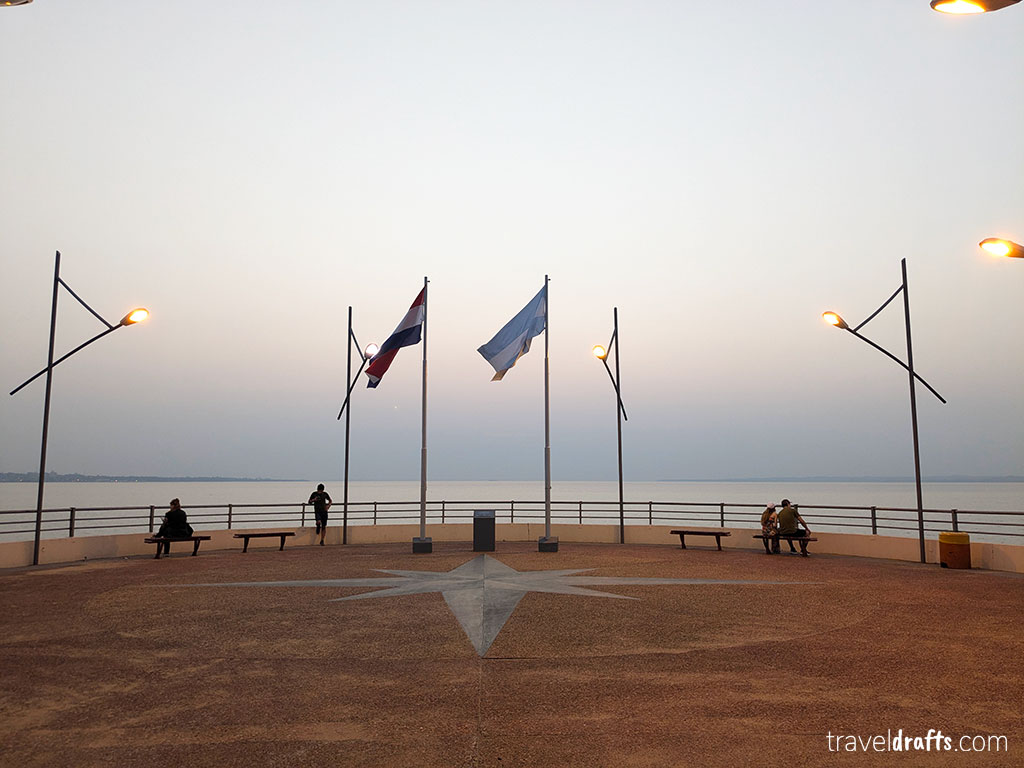
#4 Population of Paraguay
In 2024, Paraguay had about 7.5 million inhabitants, with roughly 60% of the population concentrated in urban areas, especially the capital, Asunción, and its metropolitan area.
In addition to having a relatively small population compared to other countries in the region, Paraguay’s population density is also low, especially outside Asunción. On average, there are approximately 16 people per square kilometer (41 per square mile), which is below the South American average.
When traveling through Paraguay, you’ll notice a stark contrast between urban and rural areas.
#5 Asunción and Paraguay’s Cities
Asunción is the capital and largest city, with more than one-third of the country’s population residing in its metropolitan area. While its historic center is in urgent need of renovation and investment, the city combines the charm of some historic buildings with modern elements.
Another important city is Ciudad del Este, renowned for its thriving commerce and close ties to Brazil. Encarnación stands out for its riverside promenade and unique cultural atmosphere, while cities like San Lorenzo and Capiatá reveal a strong link to the agricultural sector and local traditions.
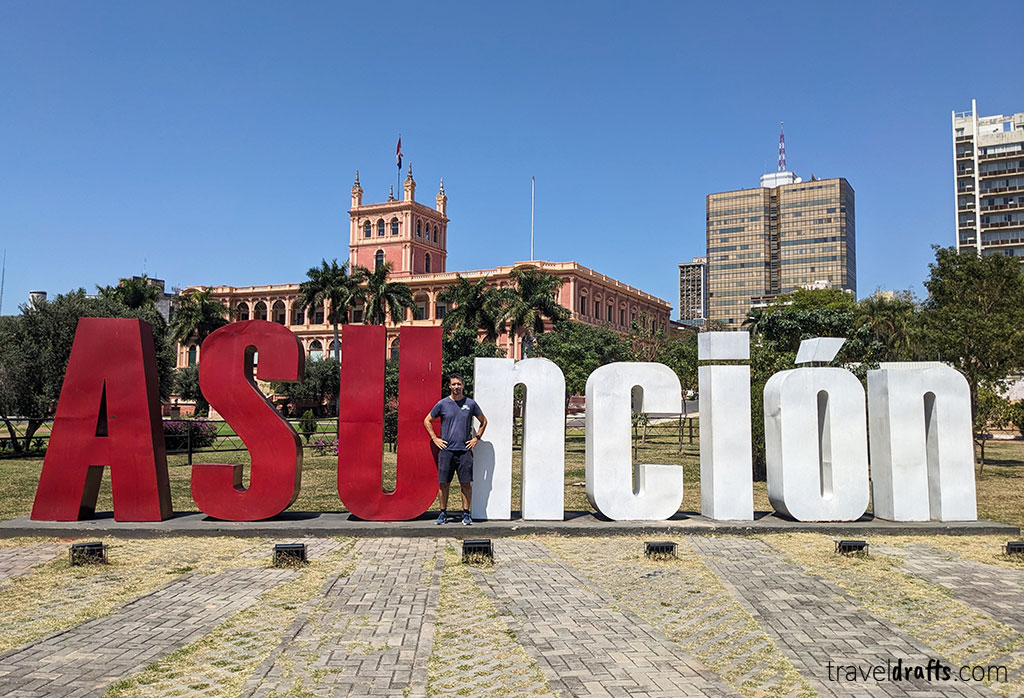
#6 European Immigration
Although Paraguay’s population is mainly mixed-race, the influence of European immigrants is significant and undeniable. Since colonial times, the arrival of Spaniards, followed by Italians, Germans, and others, has left a profound imprint on the country’s culture.
Beyond boosting demographic growth, immigration also influenced architecture, gastronomy, and urban customs. Traveling through Paraguay, you can see clear European influences—from colonial buildings to traditional dishes—blended uniquely with the country’s Indigenous heritage.
This phenomenon is comparable to what is observed in Argentina and Uruguay, where the European component is evident but with a distinct identity shaped by strong Guarani influence.
#7 Indigenous Peoples of Paraguay
Indigenous peoples were the first inhabitants of today’s Paraguay, primarily the Guarani, as well as groups such as the Enxet, Ayoreo, and Nivaclé. Since the arrival of Europeans in the 16th century, these communities underwent profound changes, facing conflicts, forced displacement, and epidemics that decimated parts of their population.
Although official numbers indicate that Indigenous people make up only about 2–3% of the current population, the cultural legacy of the Guarani, in particular, is deeply rooted in Paraguayan identity. The country’s language, customs, music, and gastronomy reflect the enduring influence of these ancestral traditions, which have been merged with colonial culture to create a unique identity.

#8 Religion in Paraguay
Although the Constitution guarantees religious freedom and states that no faith is official, Paraguay has a strong Catholic tradition, being considered one of the most religious countries in South America.
The Catholic Church has played a central role in the country’s cultural and social formation, and much of the population still identifies as Christian (over 85%), mainly Catholic. This influence is evident in festivals, rituals, and Paraguayan cultural identity itself.
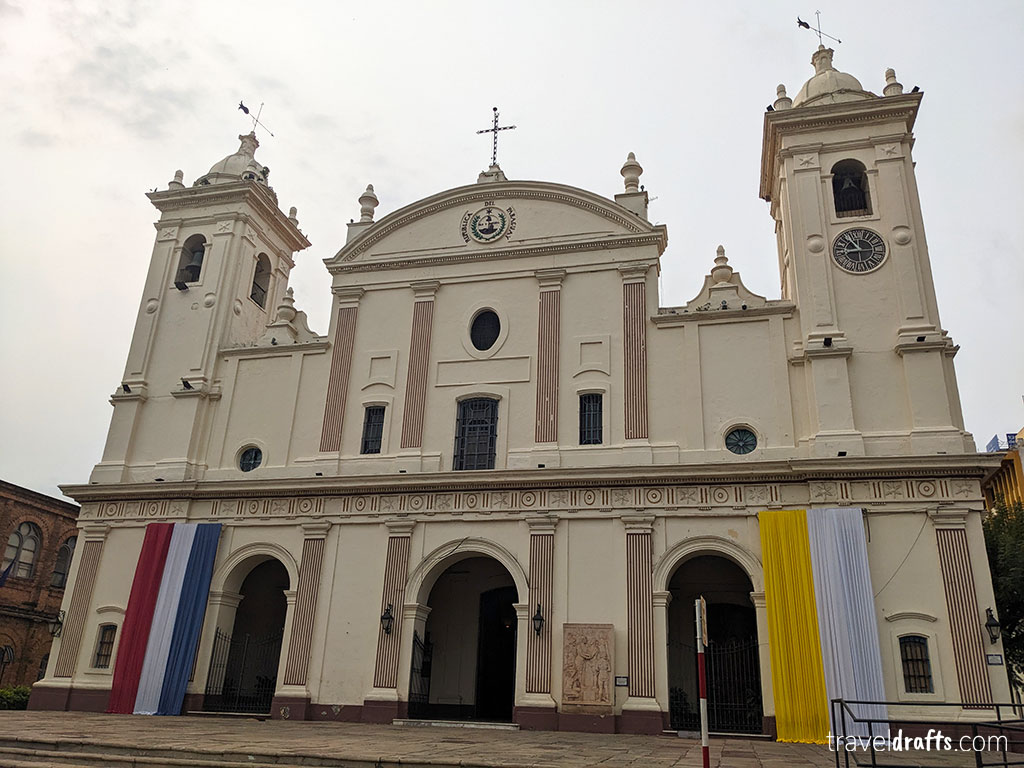
#9 What Languages Are Spoken in Paraguay?
Paraguay has two official languages: Spanish and Guarani. Nearly the entire population speaks Spanish, but Guarani also has a strong presence in daily life.
In fact, Guarani is an essential part of the country’s cultural identity, and many Paraguayans speak both languages fluently, creating a unique linguistic situation in South America. While Spanish is more common in cities, Guarani is widely used in informal conversations and is taught in schools.
Interestingly, Portuguese is also spoken as a second (or third) language by many Paraguayans, once again highlighting the cultural importance of Brazil.
#10 Which Language Should You Speak in Paraguay?
The best option is undoubtedly Spanish. However, if you don’t speak Spanish, Portuguese, or “Portuñol” can be a practical solution, especially near the Brazilian border, where many Paraguayans also speak Portuguese. Even in Asunción, you’ll find plenty of people speaking it.
The only catch is that Paraguayans often find European Portuguese unusual—they understand what you’re saying, but it doesn’t sound like the Portuguese they’re used to. It’s normal, and I find it quite curious.
In tourist centers and larger cities, you may find people who speak English, but communication in Spanish will always be easier. If you don’t speak Spanish, you might face some difficulties, as English is not widely spoken outside tourist areas.
When in doubt, a smile and a bit of patience go a long way. And of course, a translation app can always help in trickier situations.

#11 What Are Paraguayans Like?
Even though tourists often overlook Paraguay and have few internationally known attractions, you’ll find plenty of friendly people who enjoy chatting and connecting.
We felt that we were almost always treated kindly and with attention. Locals seemed happy that we were visiting their country, curious about our journey, and willing to share tips.
They also seemed to enjoy (and found it amusing) that we tried our best to speak Spanish, as it’s always curious to South Americans to hear European Portuguese, with its distinctly different sound from the Portuguese they’re accustomed to.
All of this makes traveling in Paraguay a more pleasant experience.
#12 A Fragile Economy
One thing to keep in mind when planning a trip to Paraguay is that, historically, it has had one of the weakest economies in South America. Despite its rapid growth in the early 20th century, it remains a relatively poor country.
The agricultural sector, driven by soy, corn, and cotton production, has attracted investment and boosted exports. In energy, the Itaipu Dam—built in partnership with Brazil—stands out as one of the world’s largest hydroelectric producers, contributing to economic stability and development.
These advances have helped transform Paraguay’s economy, further integrating it into global markets.

#13 The War of the Triple Alliance
The War of the Triple Alliance (1864–1870) was a devastating conflict that left a lasting mark on the country’s history. Initiated by Paraguayan dictator Francisco Solano López, the nation simultaneously faced two regional powers—Brazil and Argentina, plus Uruguay.
Isolated and with limited resources, Paraguay endured a brutal military campaign in which atrocities and massacres were widespread. The allied forces decimated the population, with losses reaching around 50%, especially among men.
The country lost approximately 25% of its territory, leaving it with a significantly reduced defense capacity, while suffering economic and social devastation that took decades to recover from.
The atrocities, combined with the expansionist ambitions of the invading nations, reshaped Paraguay, leaving behind a legacy of suffering but also resilience and determination to rebuild. Today, it is remembered as a tragic episode and a defining moment in the country’s identity and pursuit of social justice.
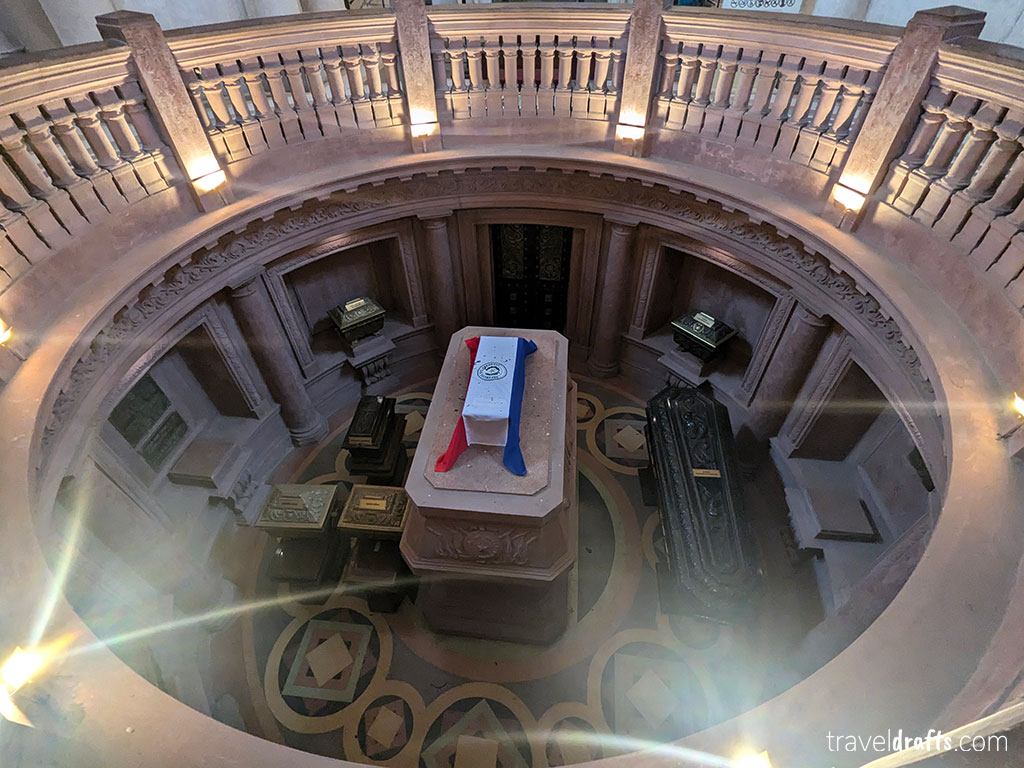
Travel Experience in Paraguay
#14 Climate in Paraguay
Paraguay can be divided into two major climate regions: the eastern area, where most of the population lives, and the Chaco.
In the eastern region, the climate is humid subtropical. Summers are very hot and humid, with temperatures often exceeding 35°C (95°F), and the rainy season lasts from November to March. Winters are milder, with highs between 18°C and 25°C (64–77°F) and cooler nights.
In the Chaco, the climate is semi-arid. Summers are extreme, reaching 40°C (104°F) or higher, with little rainfall, while winters are dry with sharp differences between day and night temperatures. Strong winds, typical of the region, intensify the heat.
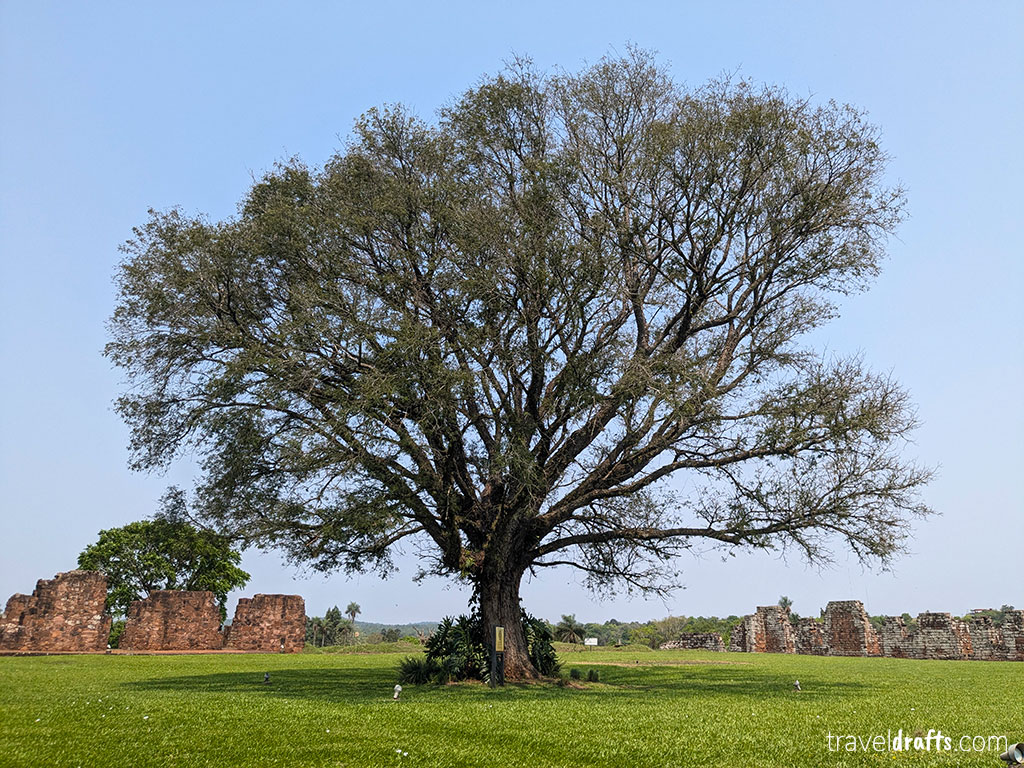
#15 Best Time to Visit Paraguay
Spring (September to November) and fall (March to May) offer the best conditions to visit Paraguay. During these seasons, temperatures are moderate, humidity levels are more comfortable, and exploring cities like Asunción or cultural sites such as the Jesuit Missions is much more enjoyable.
Another advantage is that these are off-peak times, so tourist spots will be less crowded, allowing for a more relaxed and authentic experience. That said, Paraguay rarely feels crowded anyway, since it isn’t a popular destination.
Summer (December to February) is peak season, with temperatures often above 35°C (95°F), especially in the eastern region where the main cities are located. Winter (June to August) is mild, with highs between 18°C and 25°C (64–77°F), making it a good option for those who prefer to avoid the heat and explore cities at a slower pace.
We visited Paraguay in spring, and the weather was perfect: pleasant, mild temperatures and very few tourists, which allowed us to explore at our own pace.

#16 Is Paraguay Safe to Travel?
Although we experienced no safety issues during our travels around Paraguay, it is worth noting that safety for tourists can be somewhat questionable, especially in major cities such as Asunción and Ciudad del Este. Petty theft and crime are common in busy areas and on public transportation.
We recommend checking safety conditions in the areas you plan to visit and, if possible, hiring local guides for a safer experience. Above all, avoid walking at night and be cautious, particularly in Ciudad del Este and Asunción.

#17 Is Travel Insurance Worth It?
Yes, travel insurance is always worth it—especially in a country like Paraguay. Beyond safety concerns, unexpected events can always happen, such as health issues, flight cancellations, or lost luggage.
Travel insurance provides financial protection in these situations, ensuring you can enjoy your trip with peace of mind. Medical care abroad can be expensive, but with insurance, you can access it without incurring overwhelming costs.
#18 Where Do Tourists in Paraguay Come From?
Although Paraguay is not one of South America’s top tourist destinations, it has been attracting a growing number of international visitors in recent years. In 2023, the country recorded 3,835,041 tourists, generating $1.776 billion in revenue.
Most visitors come from neighboring countries, notably Argentina (56%) and Brazil (16%). However, there has also been a notable increase in tourists from other regions, including Americans (over 100,000) and Europeans (nearly 200,000).
These numbers reflect a rise in interest from outside South America, though overall figures remain modest.
#19 A Lesser-Known International Destination
Paraguay is often overlooked by international travelers, offering a unique opportunity to explore a country that remains largely off the typical tourist routes.
This sense of tranquility and authenticity is part of Paraguay’s charm, making it appealing for those who want to discover a place few others have.
However, this is slowly changing, as Paraguay’s Ministry of Tourism has been investing in promotional campaigns and participating in global tourism fairs, aiming to diversify its visitor base and increase the country’s visibility as a travel destination.

#20 Is Paraguay Worth Visiting?
This is perhaps the most frequently asked question when considering a trip to Paraguay. The truth is that many end up visiting simply because they are already in the region and are curious—not because it’s a must-see destination. That was precisely our case.
If you’re looking for major tourist attractions, Paraguay will likely disappoint, as it doesn’t have many iconic landmarks or experiences that justify a trip on their own. Unlike its neighbors, the country isn’t geared toward tourism, which is evident in its lack of infrastructure and limited promotion of attractions.
That said, if you want to explore a less-visited country, learn more about Guarani culture, see how Paraguay differs from its neighbors, or even go shopping in Ciudad del Este, it might be worth it. And of course, there are some interesting sites like the Jesuit Missions, the Itaipu Dam, and the Chaco (for those who enjoy nature and remoteness).
In short, it really depends on what you’re looking for. But realistically, for most travelers seeking a destination packed with things to see and do, Paraguay is unlikely to rank high on the list.

Where to go in Paraguay?
#21 UNESCO World Heritage
Paraguay has just one UNESCO World Heritage Site: the Jesuit Missions of La Santísima Trinidad de Paraná and Jesús de Tavarangue, inscribed in 1993.
Located in the Itapúa department, these ruins are among the best-preserved Jesuit sites in the country. Founded in the early 18th century, they reflect colonial architecture and urban planning, showcasing the interaction between European and Guaraní cultures.

#22 Asunción
Asunción is the capital and largest city of Paraguay, and for many travelers it’s also the main entry point, especially for those arriving by plane.
One of the oldest cities in South America, Asunción is full of history. Unfortunately, its historic center is quite run-down, which is a shame since it features some exquisite colonial and neoclassical architecture.
In our view, the city reflects Paraguay’s overall travel reality: it has potential, but it isn’t tourist-oriented or prepared for large numbers of visitors. Still, it’s worth spending a day or two here to get a better sense of Paraguayan culture and everyday life.
Some things not to miss in Asunción:
- Take a walking tour of the historic center to learn more about local culture and daily life.
- Explore Mercado 4 – a chaotic maze of stalls selling everything from food and clothes to electronics, all at local prices.
- Stroll along the Costanera at sunset and enjoy views of the city and the river. On weekends, it comes alive with vendors and local families.
- Visit the National Pantheon of the Heroes – a mausoleum honoring the country’s historical figures and one of Paraguay’s most iconic buildings.
- Have lunch or dinner at Lido Bar and Bolsi. These are two of the most famous and traditional restaurants in Paraguay, perfect for trying some of the country’s best dishes. (We’ll talk more about Paraguayan food below.)

#23 Encarnación
Encarnación is one of Paraguay’s most touristic cities, mainly thanks to its proximity to Argentina and its beautiful riverside beach. It may sound odd to go to Paraguay for the beach, but the truth is the fluvial beach here is wonderful—warm, calm water, sandy shore, and plenty of parties during high season.
Outside peak season, it’s much quieter, but still great for swimming if the weather is hot. The Encarnación Costanera is also very pleasant and long, making it perfect for sunset strolls. Naturally, you’ll also find plenty of bars and restaurants overlooking the Paraná River.
Its proximity to Posadas makes it easy to hop over to Argentina and explore the region. Still, the most popular trip from Encarnación is to visit the Jesuit ruins, which we’ll cover below.
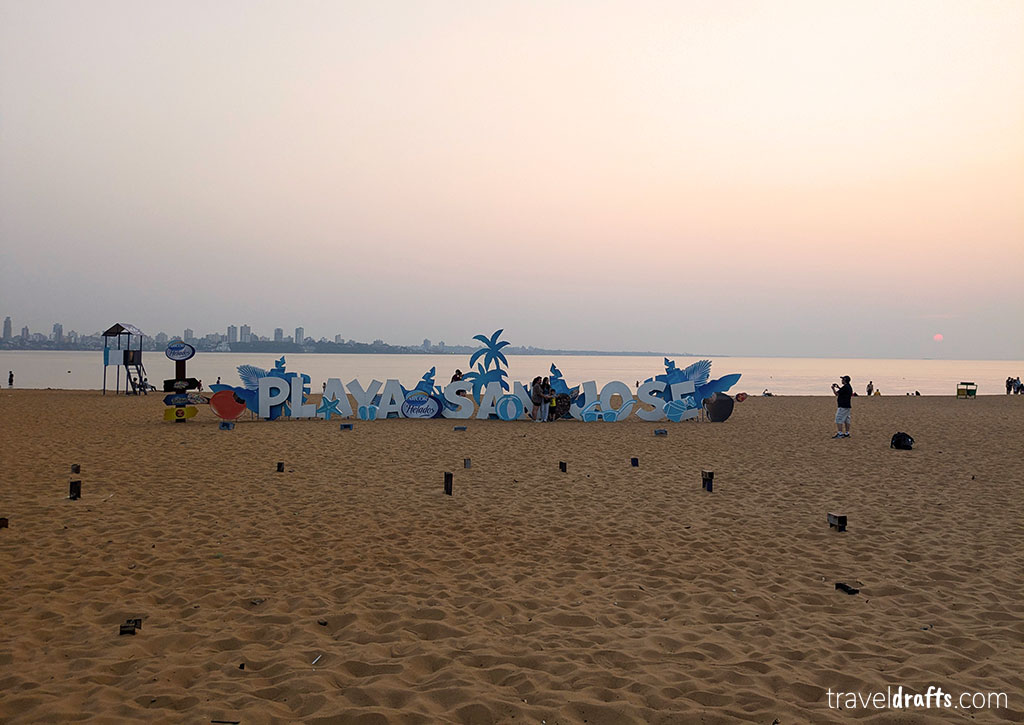
#24 Jesuit Missions
The Jesuit Missions of Trinidad and Jesús de Tavarangue are a must-visit to gain a deeper understanding of Paraguayan and South American history. Brazil and Argentina also have Jesuit missions, but the Paraguayan sites are special because they’re usually far less crowded, making the experience much more enjoyable.
These ruins are UNESCO World Heritage Sites and stand among Paraguay’s most impressive attractions. They were part of the Jesuit Missions founded in the 17th and 18th centuries to convert and protect the indigenous Guaraní people.
We only visited the Ruins of Santísima Trinidad de Paraná, which are considered the country’s most remarkable. You can reach them by public transport, but the best option is to go by car or on an organized tour. The ruins are about 30 km (19 mi) from Encarnación.

#25 Ciudad del Este
Ciudad del Este is an unusual destination. Typically, it’s not the kind of place we would visit. Still, in Paraguay we gave it a chance—mainly because it allowed us to see the Itaipu Dam and then continue to the Iguazu Falls at the Argentina–Brazil border.
💡 Tip: The Iguazu Falls are very close to Ciudad del Este. If you’re in the area, don’t miss them—they’re one of the world’s great natural wonders.
The city is best known for shopping. Thousands of Brazilians and Argentinians cross the border daily to shop, since prices are generally lower than in their home countries.
This makes Ciudad del Este a typical border city: hectic, bustling, and chaotic. Streets and malls are filled with people buying and selling—it’s an experience in itself.
The city isn’t beautiful or charming, but it’s definitely interesting for a few hours. And if you want to shop, the most popular spots are:
- Shopping Paris – Modern, with a variety of international stores.
- Shopping China – One of the largest and most organized, with competitive prices.
- SAX Department Store – A luxury option with international brands.
- Street markets – Many stalls and small shops with even lower prices.
In Ciudad del Este, we recommend using Uber for transportation. The city is large and can sometimes feel a bit unsafe. While we didn’t face any issues, the intense movement and constant crowds can make the atmosphere feel more vulnerable at times.
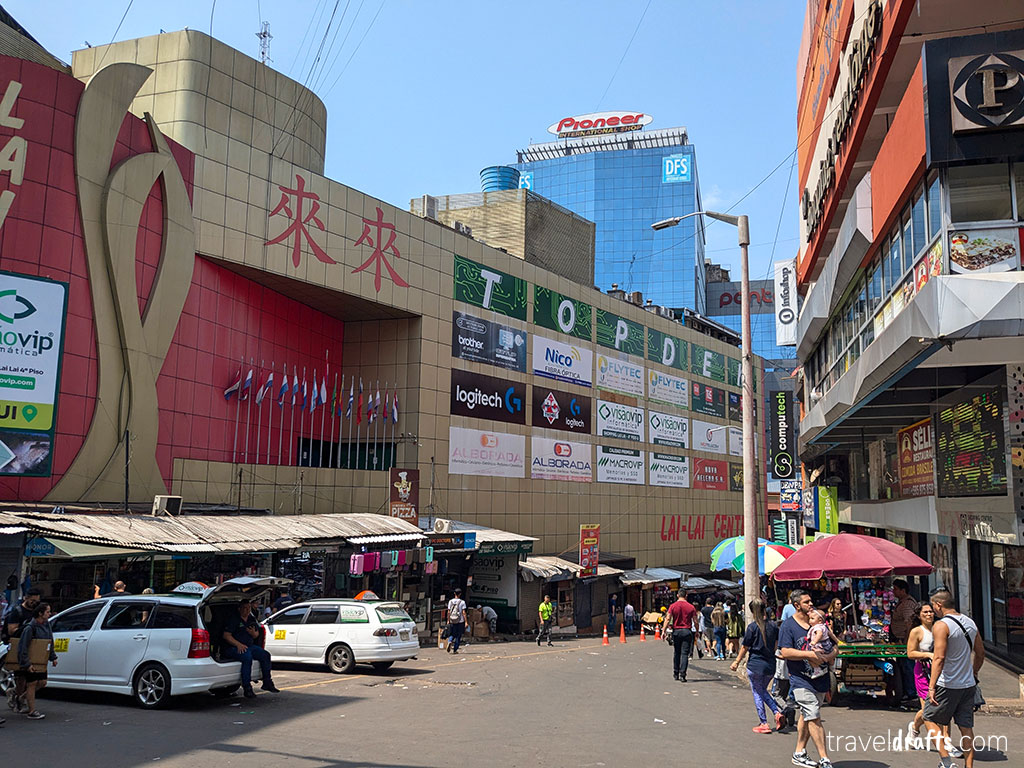
#26 Itaipu Dam
Located on the Paraná River, at the border between Paraguay and Brazil, Itaipu is one of the largest hydroelectric dams in the world in terms of energy production, supplying nearly all of Paraguay’s electricity and a significant portion of Brazil’s.
Construction began in the 1970s, marking a significant milestone in the cooperation between Paraguay and Brazil. The dam stretches 7,919 meters (26,000 ft) long and 196 meters (643 ft) high, while its reservoir covers about 1,350 km² (521 sq mi).
Visiting the dam is a fascinating experience, as it gives you a close look at the sheer scale of the project and its regional impact. It may sound odd, but it was one of our favorite activities in Paraguay—the size and power of the structure are truly impressive.
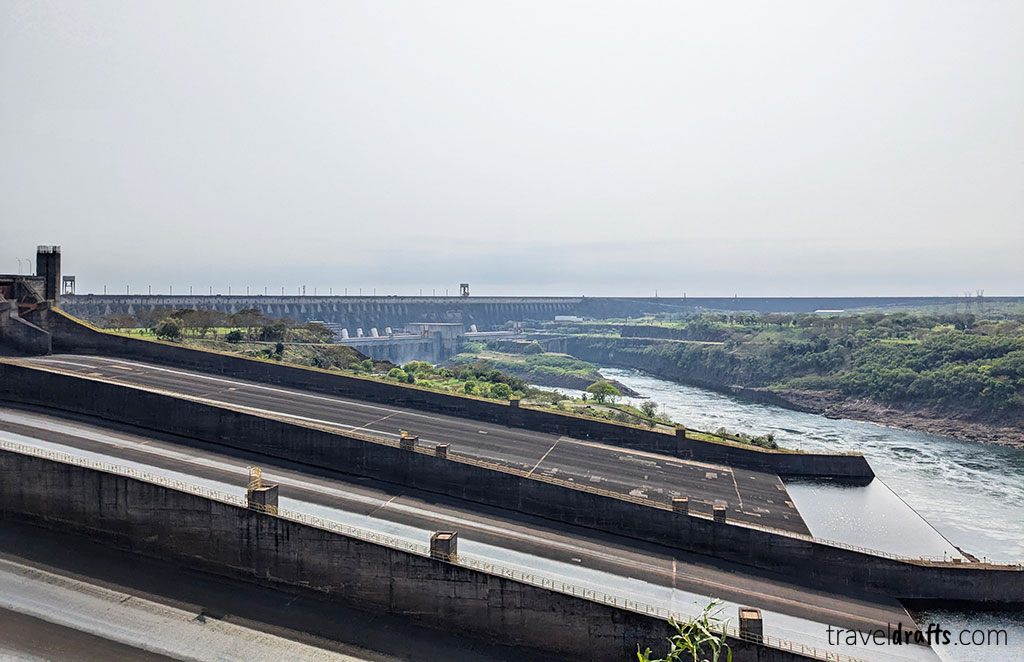
#27 Other Places to Visit in Paraguay
Above, we’ve described the places we visited and liked the most. Still, even though Paraguay isn’t a major tourist destination, there are quite a few other places worth considering:
- Filadelfia – the center of the Mennonite community in Paraguay and the main base for exploring the Chaco.
- Paraguayan Chaco – a fascinating region of harsh landscapes, cultural diversity, and rich natural life. Ideal for those seeking adventure, seclusion, and a profound connection with nature.
- Ybycuí National Park – one of the best natural areas near Asunción, with waterfalls, hiking trails, and a forest reserve.
- Cerro Corá National Park – impressive natural landscapes and an important historic site, as it was where the Paraguayan War came to an end.
- Villarrica – a charming colonial town, known for Guaraní culture and historical architecture.
- San Bernardino – on the shores of Lake Ypacaraí, a great spot for relaxation, water sports, and nightlife.
Food in Paraguay
#28 Paraguayan Cuisine
Paraguayan cuisine has indigenous roots and European influences, offering a unique gastronomic experience centered around local ingredients and recipes passed down through generations. Cassava, corn, and beef are staples of the local diet.
Although Paraguay is landlocked, its major rivers also support traditional freshwater fish dishes.
One of the things we enjoyed most about our trip was the chance to try dishes you won’t find anywhere else. In section #30, we’ll go into more detail about the dishes we liked best.

#29 The Importance of Meat in Paraguay
Meat plays a central role in Paraguayan culture and economy. The country has one of the highest cattle-to-person ratios in the world—about 2.16 head of cattle per inhabitant—second only to Uruguay. As a result, Paraguay is also among the world’s top beef exporters.
Beef is equally fundamental in the local cuisine, with very high per capita consumption. Paraguayans consume approximately 28 kg (62 lbs) of beef per person annually, ranking just behind Uruguay and Argentina.
That said, our personal experience with Paraguayan beef didn’t blow us away. It wasn’t bad at all, just not particularly memorable. What impressed us more were other unique (or nearly unique) Paraguayan dishes.
Still, it’s worth trying local beef, as you’ll find plenty of places serving good quality meat at very reasonable prices.

#30 What to Eat in Paraguay
Paraguay’s cuisine stands out thanks to a few unique dishes, while also sharing others with its neighbors. Some must-try foods include:
- Asado – Paraguayan-style barbecue, grilled meat that’s both a social and culinary tradition.
- Sopa Paraguaya – Despite the name (“Paraguayan Soup”), this is not a soup at all. It’s a savory cornbread-like dish made with fresh corn, cheese, milk, and onions. Delicious.
- Mbejú – A type of fried pancake made from cassava starch and cheese. This was probably our favorite.
- Vori Vori – A hearty soup or stew with cornmeal dumplings, chicken or beef, making for a comforting and filling meal.
- Chipa – A traditional cheese bread, usually eaten for breakfast or as a snack, reflecting European influence in local cuisine.
- Empanadas – Just like in Argentina and Uruguay, empanadas are very popular in Paraguay. They’re stuffed pastries, baked or fried, with fillings such as beef, chicken, cheese, or ham and cheese.
- Pira Caldo – A rich fish soup (since “pira” means “fish” in Guaraní), made with river fish such as dorado, surubí, or pacú, along with onions, tomatoes, peppers, and other vegetables.
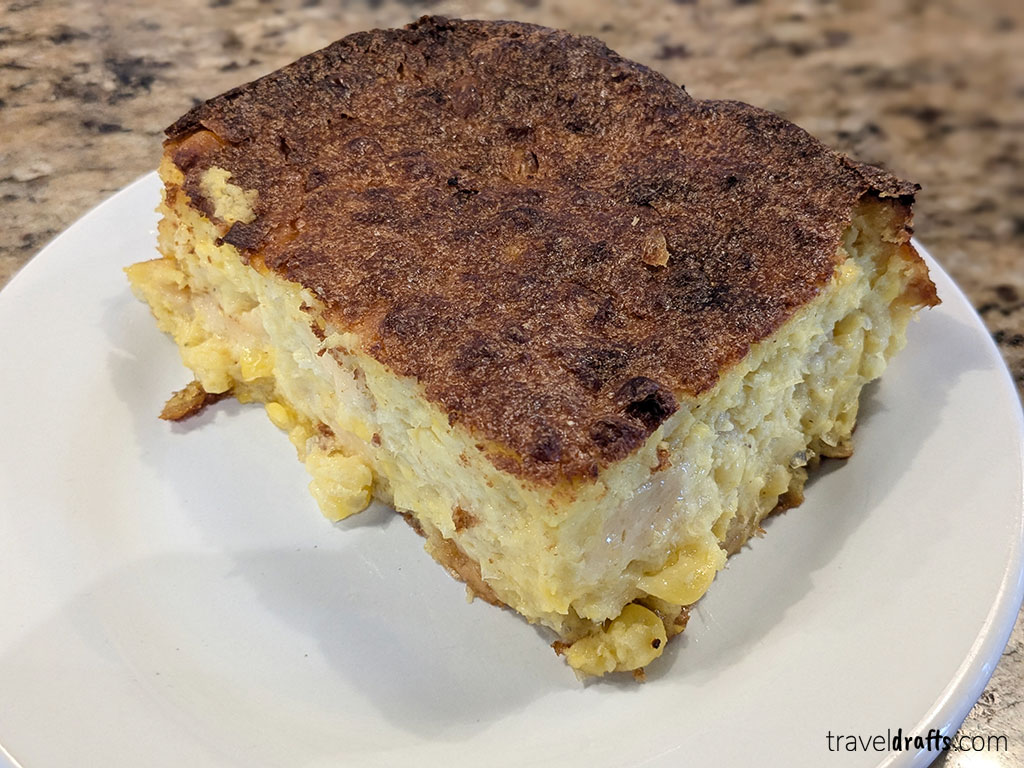
#31 Tereré – The National Drink
Tereré is Paraguay’s most traditional and iconic drink. Made with yerba mate and cold water, typically served in a gourd, it’s much more than just a refreshing beverage—it’s a symbol of socializing, hospitality, and national identity.
While hot mate is more popular in other parts of South America (especially Uruguay and Argentina), Paraguay is all about tereré. This unique tradition has replaced coffee or tea in daily life and is deeply rooted in the local culture, reflecting the Paraguayan lifestyle, adapted to both the climate and the country’s social spirit.
In Paraguay’s hot weather, tereré provides a refreshing break, enjoyed all day long, anywhere, by people of all ages and social backgrounds. It was one of the first things that struck us when we arrived: seeing everyone carrying their gourds and sipping tereré.
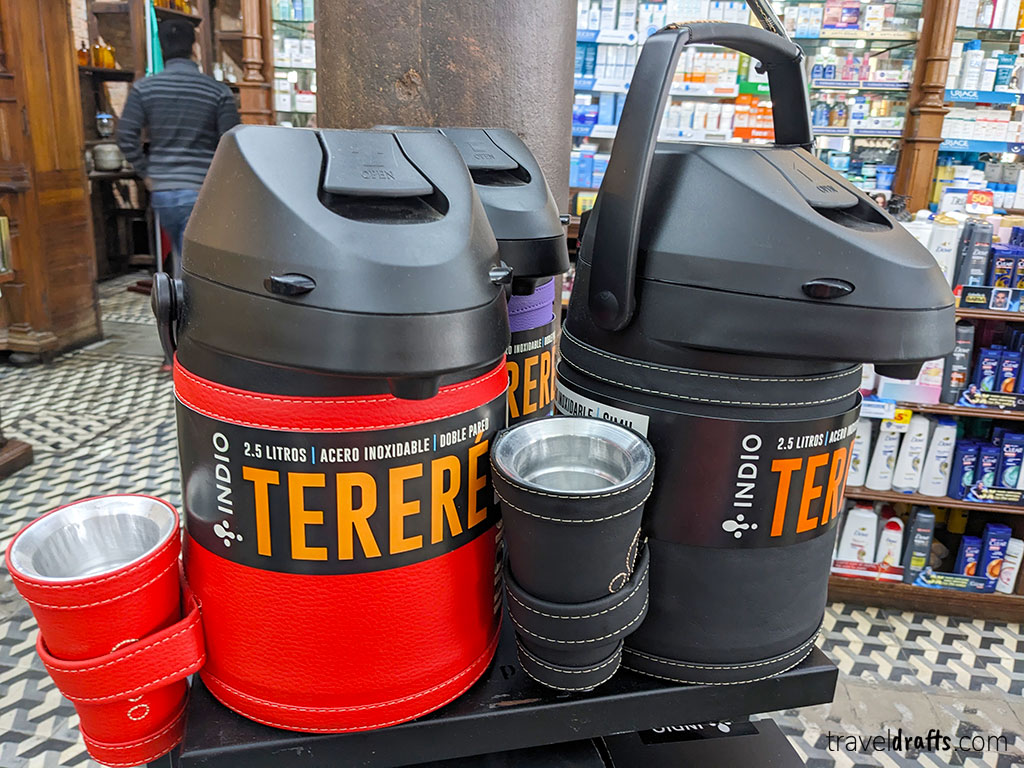
Currency and Costs of Traveling in Paraguay
#32 Currency
One of the first things to know before traveling to Paraguay is that the official currency is the Paraguayan Guaraní (PYG). As of early 2025, the official exchange rate is around 1 USD = 7,300 PYG.
Although Paraguay is a developing economy, the Guaraní has remained relatively stable, making financial planning easier for travelers. A parallel exchange market exists, but tourists will generally find that most transactions are made at the official rate, which keeps things simple.
#33 Payments and Withdrawals
You don’t need to bring Guaraní with you before arriving, since Paraguay has a vast network of ATMs where you can withdraw cash as required. Be mindful of fees, though, which, in our experience, ranged between €1.50 and €3 per withdrawal, depending on the bank and the machine.
The good news is that most businesses—such as restaurants, hotels, and stores—accept international debit and credit cards. Still, it’s a good idea to carry some cash for small purchases or when shopping at local markets and street vendors.
To minimize costs, we recommend using international debit cards that offer favorable exchange rates and low fees. We used Revolut, and it worked very well. Our strategy was to make one larger withdrawal upon arrival and then use cards for most payments. That way, we didn’t need to carry much cash while avoiding too many ATM fees.
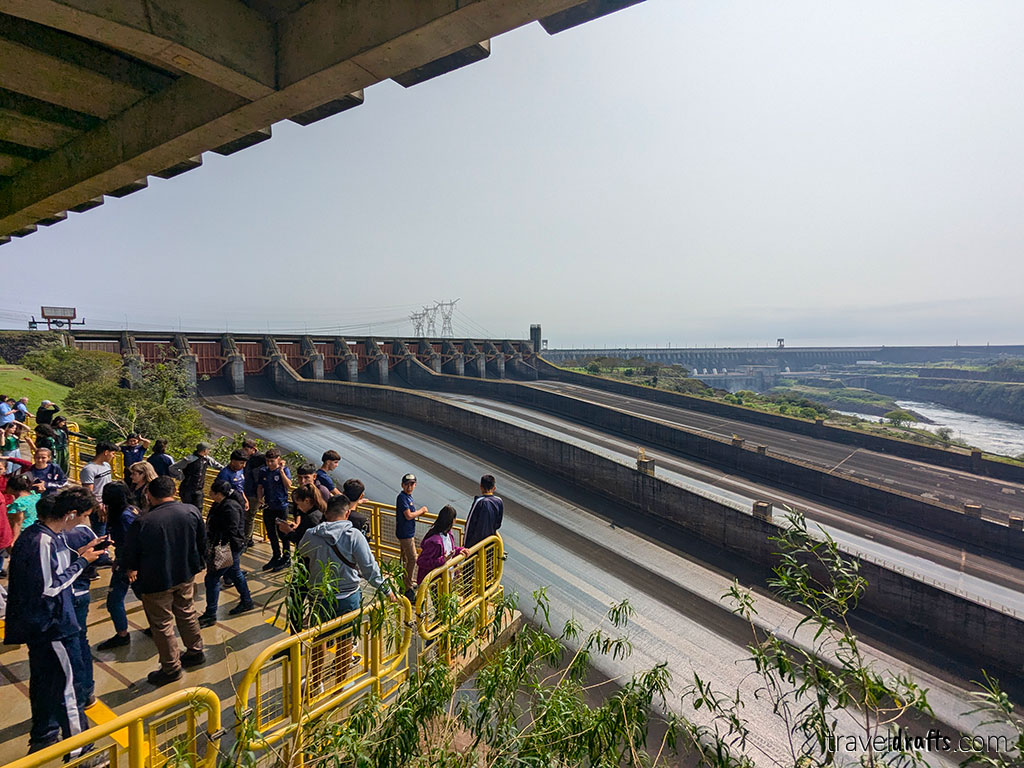
#34 Cost of Living in Paraguay
Paraguay is known as one of the most affordable countries in South America. Overall, the cost of living is approximately half that of neighboring countries.
Daily expenses are significantly lower than in Argentina, Chile, or Uruguay. For example, a full meal at a local restaurant can cost between $3 and $10, while renting an apartment in Asunción ranges from $300 to $400 per month.
#35 Daily Travel Costs in Paraguay
Excluding flights, we spent an average of €42 per day as a couple (about €21 per person) during our trip through Paraguay.
That’s extremely low, but it’s worth noting we traveled quite frugally: we saved on food, didn’t take organized tours, and most of the activities we did were free. Since we were on a more extended trip through Argentina, Chile, and Uruguay, we explored Paraguay at a slower pace—walking around cities and soaking up the local vibe without many added expenses.
We travel backpacker-style, so our spending is usually on the lower side. Costs can vary depending on the season; in our case, we visited in spring, when prices were moderate. During peak season, expect slightly higher prices, especially for accommodation.

#36 Food Costs
Eating out in Paraguay is generally inexpensive, though prices vary depending on the restaurant and city. Traditional dishes or high-quality meat restaurants are a bit pricier, but still very affordable compared to Argentina or Chile.
We tried some of the most famous local spots (such as Lido Bar, Bolsi, and Lo De Osvaldo) and found the prices fair.
For budget travelers, the best strategy is to eat where locals go, look for menu del día options, and cook occasionally if your accommodation has a kitchen—something we did at least once a day.
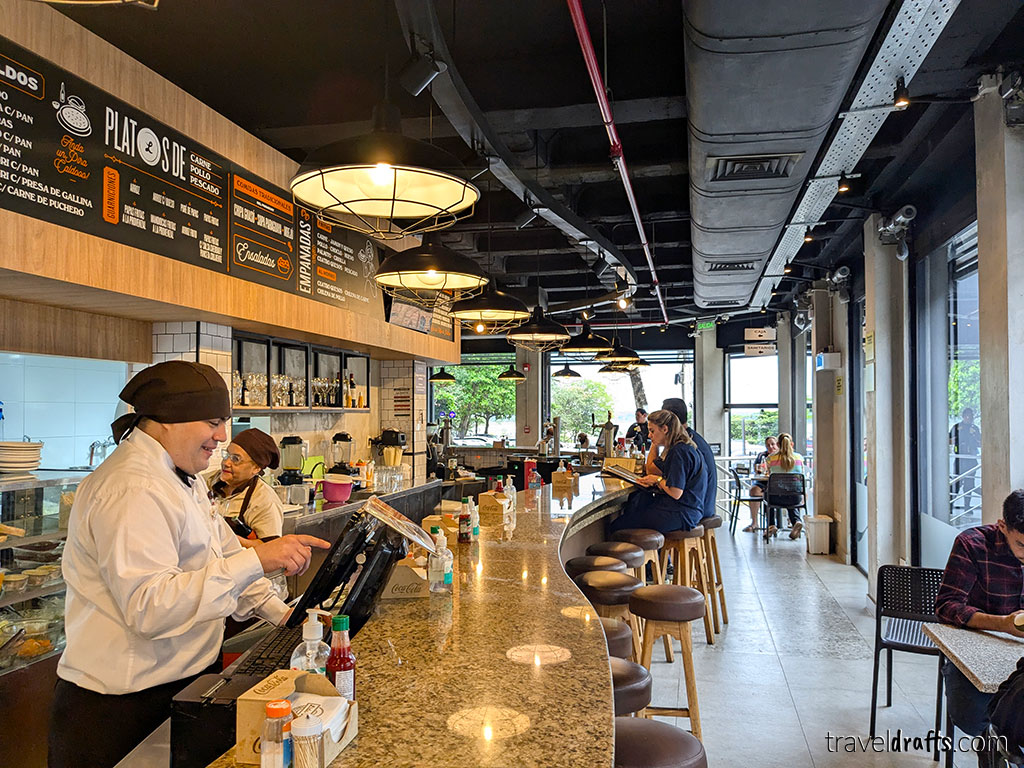
#37 Accommodation Costs
Accommodation in Paraguay is very affordable, especially compared to Argentina or Brazil.
A double room in a hostel or guesthouse can cost as little as €15–20 per night, with even cheaper options outside the major cities. Even in Asunción or Ciudad del Este, prices remain accessible, only rising during peak demand periods.
#38 Tourist Attractions
Most attractions in Paraguay are either free or very inexpensive, which helps keep travel costs low. Even our visit to the Itaipu Dam was free.
Some experiences—such as organized tours to the Jesuit Missions, Saltos del Monday, or boat trips in the Paraguayan Pantanal—can be more expensive. Still, the entry tickets themselves are usually affordable. It’s the guided tours that add up.
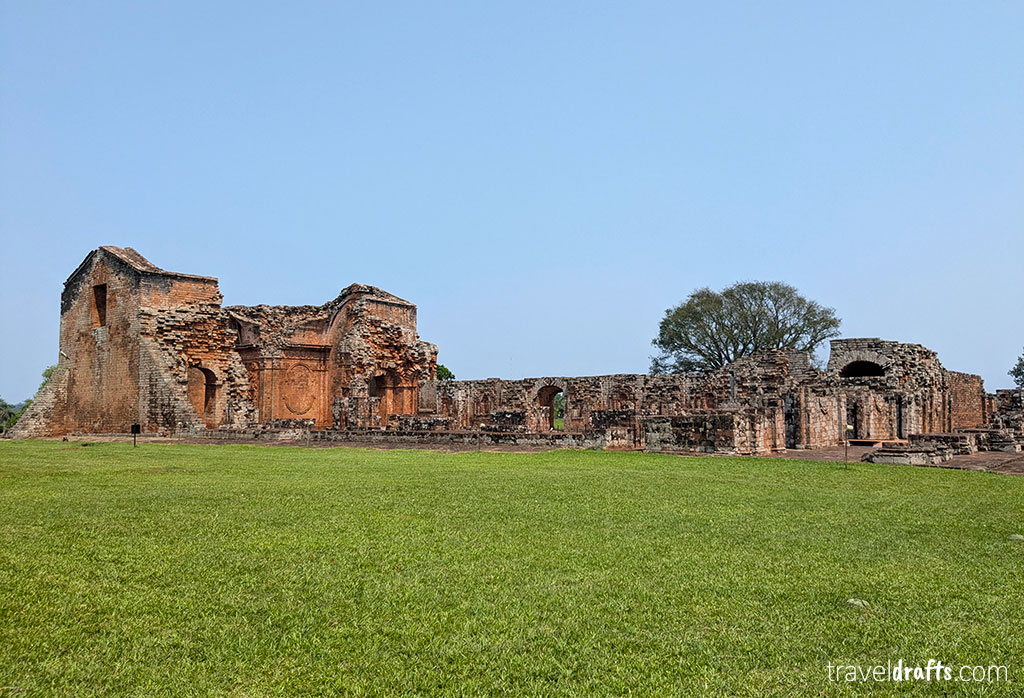
#39 Transportation Costs
Public transportation in Paraguay is basic but functional, though limited outside the major cities. In Asunción and other urban areas, we mostly walked or used Uber, which is safe, reliable, and cheap (especially when shared).
For intercity travel, buses are the most common option. They are affordable, but travel times can be long due to road conditions.
We didn’t rent a car, but from what we saw, rental prices are reasonable compared to neighboring countries.
#40 Tipping in Paraguay
In Paraguay, the term “propina” refers to a tip, which can be confusing for Portuguese speakers since it also means “bribe” in Portugal. Tipping is not really part of the culture, but it’s always appreciated as a gesture of gratitude.
Locals rarely leave tips at restaurants, and they’re rarely included in the bill. In tourist-friendly places, staff may ask if you’d like to add one, but it’s entirely optional.
While not an essential part of workers’ income in Paraguay, leaving a small tip is a nice way to show appreciation—especially considering local salaries are pretty low.

How to Travel in Paraguay
#41 What Transportation to Use in Paraguay
During our stay in Paraguay, we utilized a combination of transportation options, including Uber, buses, and taxis. We chose not to rent a car, instead opting for long-distance intercity buses and using Uber and local buses to get around within cities. This allowed us to enjoy a more relaxed trip without the stress of driving.
Public transport in Paraguay is basic but functional, especially in the main cities. Buses between cities are a good choice, although journeys can take longer than expected due to road conditions. Within cities, Uber works very well—it’s convenient and affordable, though more expensive than local buses.
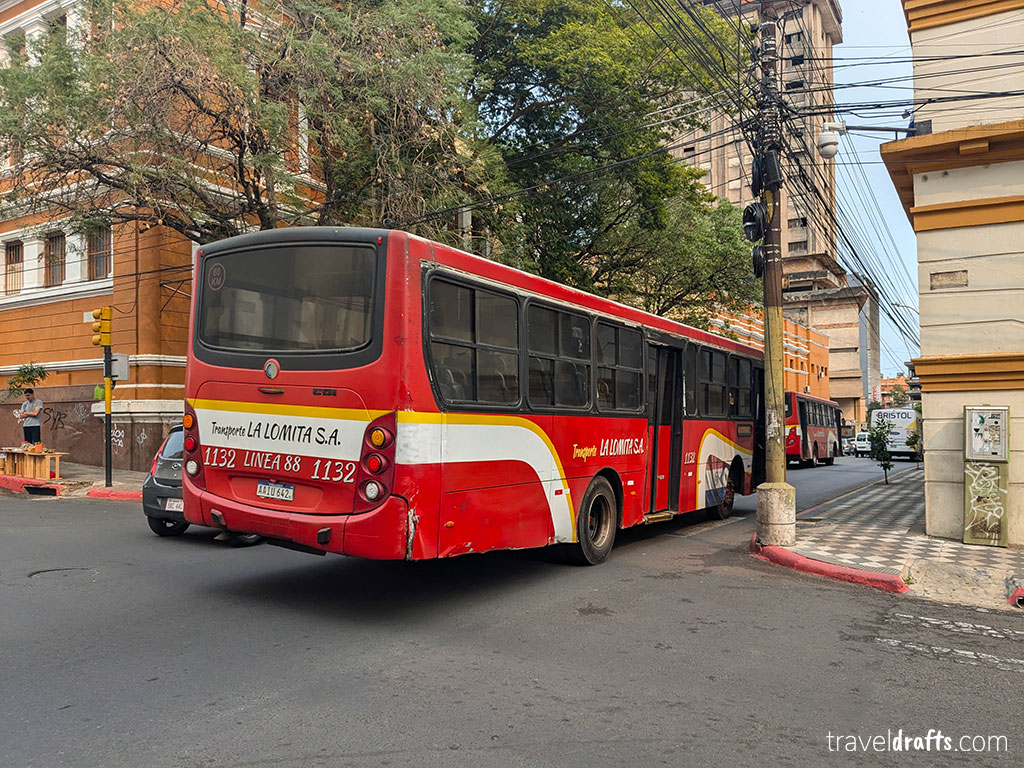
#42 Public Transport
Traveling between Paraguay’s larger cities is relatively straightforward and, in our opinion, safe. However, the infrastructure isn’t as developed as in some neighboring countries. Still, there are plenty of affordable options depending on your travel needs.
Intercity buses are by far the best way to travel between destinations. There are multiple routes covering almost every major city, though travel times can be surprisingly long for such a small country, primarily due to road conditions.
One important note: in Asunción, you need a transport card to use local buses. Buying this card can be frustrating—we had to check several shops before finally finding one, and surprisingly, it wasn’t available at the airport when we arrived. If you don’t want the hassle, stick with Uber.
Some cross-border trips are also interesting options:
- Train between Posadas (Argentina) and Encarnación (Paraguay): A quick, comfortable, and very cheap way to cross.
- Bus between Ciudad del Este and Puerto Iguazú (Argentina): A quirky journey because it briefly passes through Brazil without requiring formal entry with your passport. Don’t forget you still need to exit Paraguay officially.
If you want to explore more remote regions or prefer flexibility, renting a car can be a good choice, especially for groups. Otherwise, organized tours may be the easiest way to reach attractions that are hard to access by bus.

#43 Renting a Car in Paraguay
Car rental in Paraguay is quite affordable, although prices vary depending on the season. During the shoulder season, you can find rentals starting at €200 per week if booked in advance through platforms like Discover Cars.
Prices rise during peak travel times, especially in tourist hotspots like Encarnación and Ciudad del Este. Renting a car gives you more freedom to explore rural areas that are not well served by public transportation, and it can save money compared to joining guided tours.
Since we chose not to rent a car, we can’t share personal tips. Still, based on our research, the process is standard: international companies are available, and vehicles are generally suitable for the roads in Paraguay. As always, we recommend taking photos or a video of the car’s condition before driving off, to avoid disputes later.
#44 Driving in Paraguay
As mentioned, we didn’t drive ourselves, but we observed that traffic in Asunción and Ciudad del Este is chaotic.
If possible, avoid driving in these cities. In Ciudad del Este in particular, traffic jams can be endless—you may spend hours just trying to move across town. Uber or buses are better alternatives.
In rural areas, driving is calmer and far less stressful. However, local drivers don’t always follow traffic rules. Main highways are generally in good condition, but in remote areas, roads can be rough and require vehicles with more robust capabilities.
If you have experience driving abroad, you shouldn’t face significant difficulties. Just keep a defensive driving mindset and adapt to local habits.
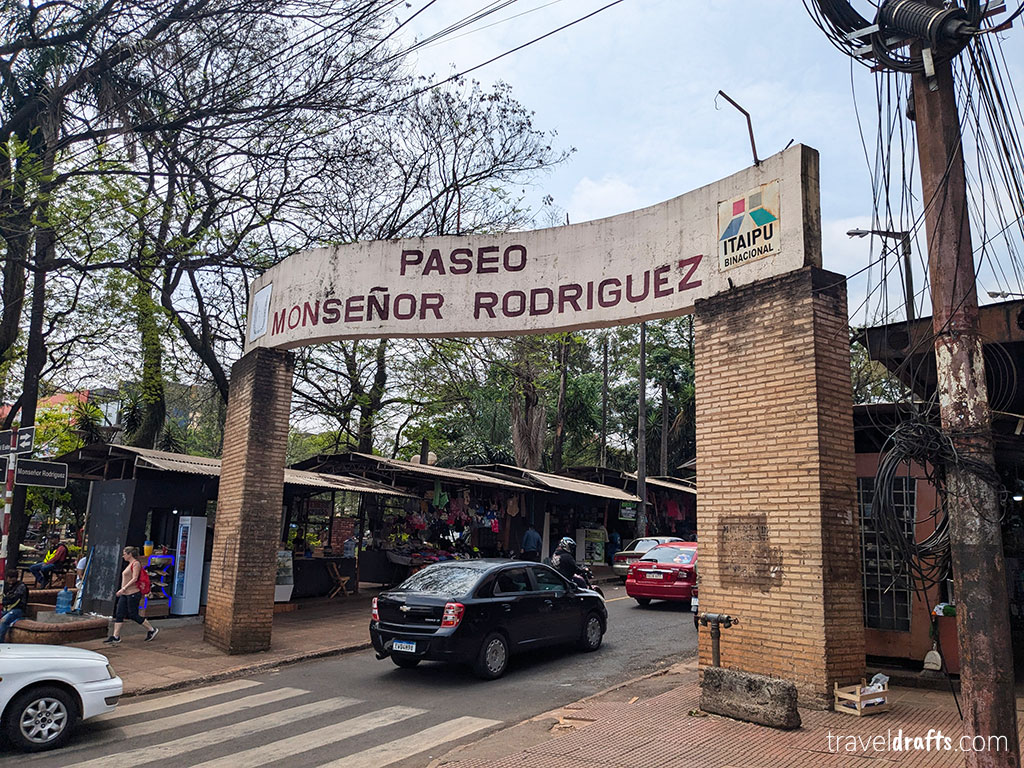
Other Travel Tips for Paraguay
#45 Internet in Paraguay
The telecommunications infrastructure is decent, and most hotels and guesthouses offer complimentary Wi-Fi. However, quality can vary—especially outside big cities—so check reviews beforehand if you need a reliable connection for work or streaming.
For mobile data, buying a local SIM or eSIM is the best option. SIM cards are inexpensive and readily available at carrier shops or convenience stores. The process is straightforward: buy, register, and activate.
Prices are very low across all providers. We used Claro, and it worked fine—about €5 per person for our data needs.
#46 Souvenirs to Buy in Paraguay
Though not as touristy as its neighbors, Paraguay offers authentic and unique souvenirs that reflect its culture and traditions. Some of the best things to bring home include:
- Leather goods – wallets, belts, and shoes of good quality.
- Ñandutí – colorful handmade lace, perfect as décor or accessories.
- Ao Po’i – traditional hand-embroidered fabric used for clothes and tableware.
- Tereré & Cuia – the cold yerba mate drink is a Paraguayan cultural symbol; bringing a gourd and bombilla (metal straw) makes a great gift.
- Yerba mate for Tereré – essential for recreating the tradition at home.
- Packaged Chipa – traditional cheesy bread, available in a version suitable for travel.

#47 Cleanliness and Sustainability in Paraguay
Paraguay is not the cleanest country we’ve visited. In cities like Asunción and Ciudad del Este, we observed significant litter and poor upkeep of public spaces.
The historic center of Asunción, in particular, was in a state of disrepair, with crumbling buildings and neglected streets. Ciudad del Este is even more chaotic and messy.
Outside major cities, conditions vary: tourist areas and modern neighborhoods are better maintained, but overall, waste management and urban cleanliness don’t seem to be priorities.
On the sustainability side, Paraguay is a major producer of hydropower thanks to the Itaipu Dam, one of the largest in the world. Still, environmental challenges like deforestation and river pollution remain significant.
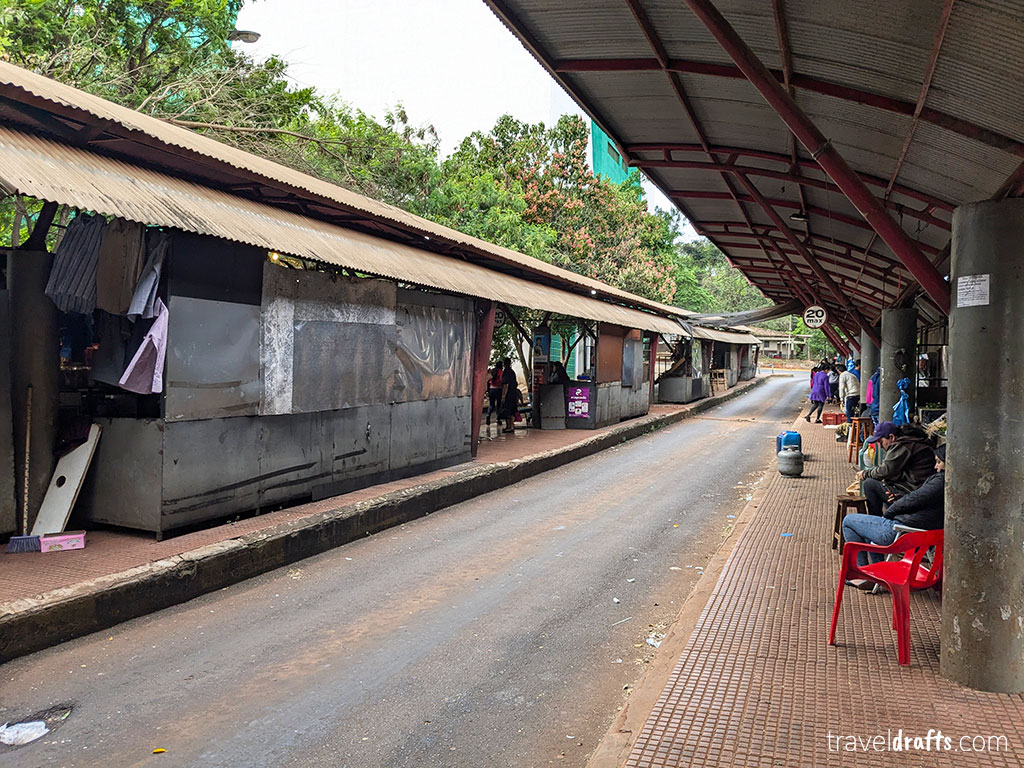
#48 Electrical Outlets in Paraguay
Power outlets in Paraguay are Type C and Type F, with 220V / 50Hz. Travelers from continental Europe (including Portugal) won’t need an adapter.
#49 Entry Requirements for Paraguay
Portuguese citizens (and many other nationalities) do not need a visa for tourist stays of up to 90 days. Similarly, Brazilian citizens can enter with just their national ID (RG), without a passport or visa.
Of course, this exemption applies only to tourism. If you plan to work or study in Paraguay, you’ll need the appropriate visa.
We also recommend carrying proof of onward travel and evidence of sufficient funds, as immigration officers may request these.
#50 Paraguay Travel Guide
If you’re looking for a reliable travel guide to Paraguay, we recommend the Bradt Guide. It includes practical tips about Paraguay and even short excursions into Brazil and Argentina to visit Iguazú Falls.
Pin it for later!

